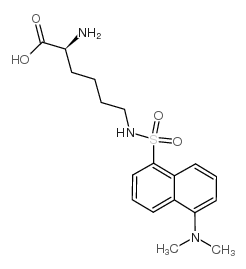Dansyllysine

Dansyllysine structure
|
Common Name | Dansyllysine | ||
|---|---|---|---|---|
| CAS Number | 1101-84-4 | Molecular Weight | 379.47 | |
| Density | 1.293g/cm3 | Boiling Point | 594.1ºC at 760mmHg | |
| Molecular Formula | C18H25N3O4S | Melting Point | N/A | |
| MSDS | USA | Flash Point | 313.1ºC | |
|
Determination of binding conformations of drugs to human serum albumin by transferred nuclear overhauser effect measurements and conformational analyses using high-temperature molecular dynamics calculations.
J. Pharm. Sci. 87 , 379-386, (1998) The binding conformations of oxyphenbutazone (OXY), Nepsilon-dansyl-L-lysine (DNS-LYS), and furosemide (FU) to human serum albumin (HSA) have been investigated by molecular dynamics (MD) calculations and transferred nuclear Overhauser effect (TRNOE) measureme... |
|
|
Cholesterol-free phospholipid domains may be the membrane feature selected by N epsilon-dansyl-L-lysine and merocyanine 540.
Biochem. Biophys. Res. Commun. 111(2) , 768-74, (1983) We have used N epsilon-dansyl-L-lysine as a fluorescent membrane probe, to study cells taken from tissues concerned with immune function. There is a striking similarity between the staining selectivity of this compound and that reported by others for merocyan... |
|
|
The use of dansyl lysine to assess heat damage and thermotolerance of normal tissues.
Int. J. Radiat. Oncol. Biol. Phys. 14(5) , 983-8, (1988) The fraction of cells excluding the fluorescent dye dansyl lysine has previously been shown to correlate well with heat-induced cell killing in a variety of mammalian cell lines and in murine tumors in vivo. Here we evaluate the usefulness of dansyl lysine as... |
|
|
Measurement of DNA and antigen expression of live cells using three fluorochromes and two detectors.
Cytometry 11(4) , 533-8, (1990) In a multiparameter flow cytometric study, the fluorescence from the two different dyes fluorescein and dansyl-lysine were detected in the same spectral interval on the same photomultiplier tube, using two lasers to excite the fluorochromes at two separate la... |
|
|
Dansyl lysine: a structure-selective fluorescent membrane stain?
Biophys. J. 42(3) , 307-10, (1983) Dansyl lysine (DL) is a fluorescent compound that has significantly higher solubility in synthetic phosphatidylcholine (PC) membranes with a low cholesterol content than it does in water or in membranes having a high cholesterol content. Its fluorescence inte... |
|
|
Heterogeneity of heat response in murine, canine and human tumors: influence on predictive assays.
Int. J. Radiat. Oncol. Biol. Phys. 20(3) , 479-88, (1991) The heterogeneity of response to hyperthermia of cells taken from different regions of tumors was tested in a model tumor system (RIF-1) in the mouse and in specimens from spontaneous tumors taken from dogs and humans at the time of surgical resection. Cell s... |
|
|
Estimation of helix-helix association free energy from partial unfolding of bacterioopsin.
Biochemistry 43(2) , 550-9, (2004) To obtain thermodynamic information about interactions between transmembrane helices in integral membrane proteins, partial unfolding of bacterioopsin in ethanol/water mixtures was studied by Förster-type resonance energy transfer (FRET) from tryptophan to a ... |
|
|
Antibody interaction with a membrane-bound fluorescent ligand on synthetic lipid vesicles.
Biochemistry 21(23) , 5738-44, (1982) The interaction of membrane-bound ligand with bivalent and monovalent fragments of monoclonal antibody was studied by fluorescence and precipitation analysis using synthetic lipid vesicles. The ligand N epsilon-[5-(dimethylamino)-naphthyl-1-sulfonyl]lysine wa... |
|
|
Lateral phase separation of phospholipids as a basis for increased permeability of membranes towards fluorescein and other chemical species.
J. Membr. Biol. 80(3) , 249-56, (1984) Using mouse spleen cells, before and after treatment with glutaraldehyde or mild hyperthermia, we observe a strong correlation between permeability to fluorescein and susceptibility to staining with N epsilon-dansyl-L-lysine (irrespective of the cells' abilit... |
|
|
Membrane structure and the tenuously maintained resistance to staining with N epsilon-dansyl-L-lysine shown by many cells.
J. Membr. Biol. 77(2) , 115-22, (1984) The ability to resist staining by N epsilon-dansyl-L-lysine is tenuously maintained in the majority of live nucleated cells taken from tissues concerned with immune function. Resistance is lost under a variety of nonphysiological conditions known to, or likel... |